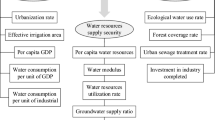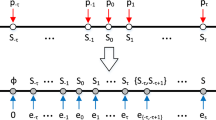Abstract
Nowadays, water security is becoming increasingly prominent and the water security problem becomes a primary bottleneck restricting China’s future sustainable development. Water security in China is thus worth conducting an in-depth study. This paper aims to explore an effective water security evaluation method. Based on the proposed definition of water security, an evaluation index system of water security is first built from the perspective of “pressure–state–response” conceptual model. Considering the indicators’ uncertainty and the decision makers’ (DMs’) limited knowledge, the DMs usually use linguistic terms to express their judgements. As a new type of linguistic variable, probabilistic linguistic term set (PLTS) not only allows the DMs to express their judgements with multiple linguistic terms but also can reflect the DMs’ different preference degrees over these possible linguistic terms. For the water security issue under probabilistic linguistic environment, a programming model is developed to derive the attribute weights. Then, the TODIM (an acronym in Portuguese for interactive multi-criteria decision making) method, which considers the psychological factors of the DMs, is used to evaluate water security based on the PLTS. Furthermore, a case study is conducted and some discussions and comparative analysis are carried out according to the case results.

Similar content being viewed by others
References
Bakker K (2012) Water security: research challenges and opportunities. Science 337:914–915
Chang YT, Liu HL, Bao AM, Chen X, Wang L (2015) Evaluation of urban water resource security under urban expansion using a system dynamics model. Water Sci Technol Water Supply 15:1259–1274
Cook C, Bakker K (2012) Water security: debating an emerging paradigm. Glob Environ Change 22:94–102
Dai WY, Zhang R, Cheng ZY et al (2015) Research on water ecological security index system in Lanzhou based fuzzy comprehensive evaluation. Arid Zone Res 4:025
French S, Hartley R, Thomas LC, White DJ (1983) Multi-objective decision making: based on the proceedings of a conference on multi-objective decision making. Academic Press, New York
Gerlak AK, House-Peters L, Varady RG, Scott CA (2018) Water security: a review of place-based research. Environ Sci Policy 82:79–89
Global Water Partnership (2000) Towards water security: a framework for action. Global Water Partnership (GWP), Stockholm
Gong L, Jin CL (2014) Urban water security evaluation system based on water poverty index. J Hydroelectr Eng 33:84–90
Gong L, Jin CL, Li YX, Zhou ZL (2017) A novel water poverty index model for evaluation of Chinese regional water security. In: IOP conference series: earth and environmental science. https://doi.org/10.1088/1755-1315/82/1/012029
Han BL, Liu HX, Wang RS (2015) Urban ecological security assessment for cities in the Beijing-Tianjin-Hebei metropolitan region based on fuzzy and entropy methods. Ecol Model 318:217–225
Hwang CL, Yoon K (1981) Multiple attribute decision making: methods and applications. Springer, Berlin
Jiang Y (2015) China’s water security: current status, emerging challenges and future prospects. Environ Sci Policy 54:106–125
Jiang YP, Liang X, Liang HM (2017) An I-TODIM method for multi-attribute decision making with interval numbers. Soft Comput 21:5489–5506
Kahneman D, Tversky A (1979) Prospect theory: an analysis of decision under risk. Econometrica 47:263–292
Li CH, Sun L, Jia JX, Cai YP, Wang X (2016) Risk assessment of water pollution sources based on an integrated k-means clustering and set pair analysis method in the region of Shiyan. China Sci Total Environ 557:307–316
Li DL, Wu SY, Liu LB, Liang Z, Li SC (2017) Evaluating regional water security through a freshwater ecosystem service flow model: a case study in Beijing-Tianjian-Hebei region. China Ecol Indic 81:159–170
Liao HC, Xu ZS, Zeng XJ, Merigó JM (2015) Qualitative decision making with correlation coefficients of hesitant fuzzy linguistic term sets. Knowl Based Syst 76:127–138
Liu KK, Li CH, Cai YP, Xu M, Xia XH (2014) Comprehensive evaluation of water resources security in the Yellow River basin based on a fuzzy multi-attribute decision analysis approach. Hydrol Earth Syst Sci 18:1605–1623
Lu SB, Bao HJ, Pan HL (2016) Urban water security evaluation based on similarity measure model of vague sets. Int J Hydrogen Energy 41:15944–15950
Luo B, Jiang SZ, Zheng YR, Chang TT, Peng WF (2016) Application of water poverty index based on the entropy weight method to water security evaluation of Sichuan Province. J Sichuan Normal Univ (Nat Sci) 4:029
Men BH, Liu HY (2018) Water resource system vulnerability assessment of the Heihe River Basin based on pressure-state-response (PSR) model under the changing environment. Water Sci Technol Water Supply. https://doi.org/10.2166/ws.2018.017
Pang Q, Xu ZS, Wang H (2016) Probabilistic linguistic term sets in multi-attribute group decision making. Inf Sci 369:128–143
Rodriguez RM, Martinez L, Herrera F (2012) Hesitant fuzzy linguistic term sets for decision making. IEEE Trans Fuzzy Syst 20:109–119
Shao DG, Yang FS, Xiao C, Tan XZ (2012) Evaluation of water security: an integrated approach applied in Wuhan urban agglomeration. China Water Sci Technol 66:79–87
Thapa BR, Ishidaira H, Pandey VP, Bhandari TM, Shakya NM (2018) Evaluation of water security in kathmandu valley before and after water transfer from another Basin. Water 10:224
Veettil AV, Mishra AK (2016) Water security assessment using blue and green water footprint concepts. J Hydrol 542:589–602
Wei RJ, Liang C, Ren C, Zhao L (2013) Variable fuzzy recognition method of water resources security evaluation in Songhua Dam. South North Water Transf Water Sci Technol 11:1–5
Xu ZS (2005) Deviation measures of linguistic preference relations in group decision making. Omega 33:249–254
Xu ZS (2012) Linguistic decision making: theory and methods. Springer, Berlin
Yao JP, Ren YT, Wei S, Pei W (2018) Assessing the complex adaptability of regional water security systems based on a unified co-evolutionary model. J Hydroinf 20:34–48
Yin S, Guan DJ, Su WC, Gao WJ (2017) Integrated assessment and scenarios simulation of urban water security system in the southwest of China with system dynamics analysis. Water Sci Technol 76:2255–2267
Yu HZ, Han M (2015) TOPSIS evaluation of water resource security in Shandong Province based on fuzzy matter-element model. Saf Environ Eng 6:001
Zadeh LA (1975) The concept of a linguistic variable and its application to approximate reasoning–I. Inf Sci 8:199–249
Zhang JY, Wang LC (2015) Assessment of water resource security in Chongqing City of China: what has been done and what remains to be done? Nat Hazards 75:2751–2772
Zhang YX, Xu ZS, Wang H, Liao HC (2016) Consistency-based risk assessment with probabilistic linguistic preference relation. Appl Soft Comput 49:817–833
Author information
Authors and Affiliations
Corresponding author
Ethics declarations
Funding
This study was funded by the National Natural Science Foundation of China (Nos. 71571123, 71771155, 71501135, 71771156), the Young scholars high level academic team construction project at Sichuan University (skgt201501), and the Scientific Research Foundation for Excellent Young Scholars at SCU (No. 2016SCU04A23).
Conflict of interest
The authors declare that they have no conflict of interest.
Ethical approval
This article does not contain any studies with human participants or animals performed by any of the authors.
Informed consent
Informed consent was obtained from all individual participants included in the study.
Additional information
Communicated by V. Loia.
Publisher's Note
Springer Nature remains neutral with regard to jurisdictional claims in published maps and institutional affiliations.
Rights and permissions
About this article
Cite this article
Zhang, Y., Xu, Z. & Liao, H. Water security evaluation based on the TODIM method with probabilistic linguistic term sets. Soft Comput 23, 6215–6230 (2019). https://doi.org/10.1007/s00500-018-3276-9
Published:
Issue Date:
DOI: https://doi.org/10.1007/s00500-018-3276-9




